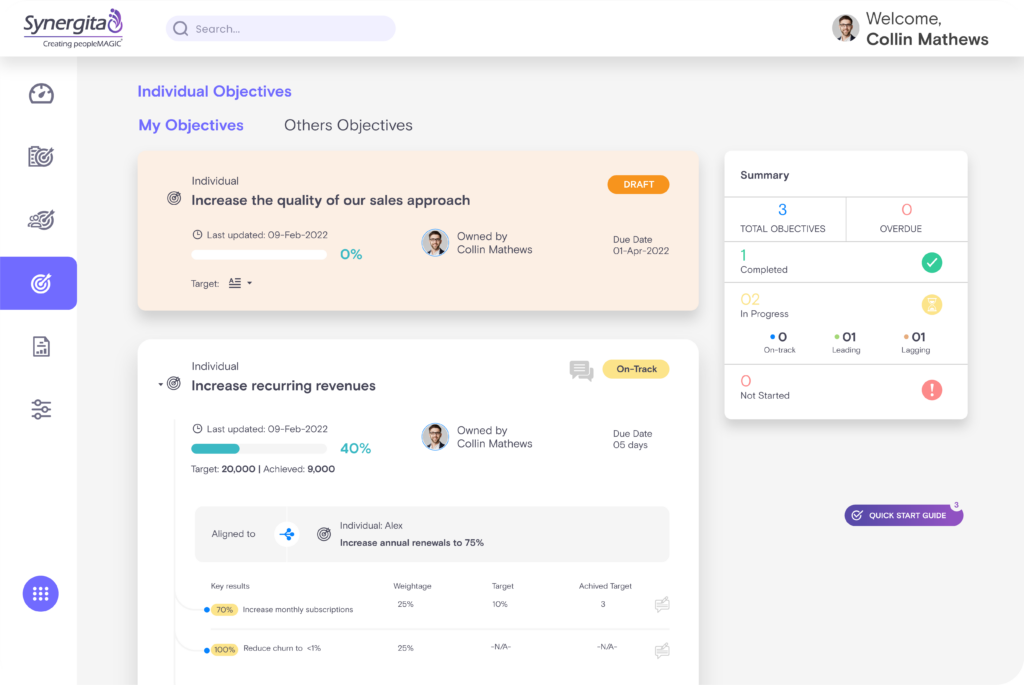The Ultimate OKR Rollout Checklist for 2023
With the new year lurking around the corner, you have decided to employ OKRs to up your business game. Even with detailed research, you might find the implementation of OKRs very demanding. But there is no need to worry. This article tells you everything you need to know about the OKR rollout. From planning to implementation, you’ll find all the trivial information on OKR that helps you successfully manage the process.
OKRs, with their agility and customization, can be a great New Year’s present for your employees. It totally depends on the companies and organizations as to how the framework should be rolled out. Some roll it out for a month, while others have found it helpful to apply it gradually, piloting the OKR method with a single team before adopting it across the entire organization.

How should you plan your OKR rollout?
One of the most common pitfalls during OKR implementation is trying to execute the process for a long time with a large number. Therefore, it is always wise to start small. Although it can require an extended implementation period, a trial rollout will allow you to:
- Experiment with different options and ways.
- Assess what works (and what does not).
- Identify bottlenecks and solutions.
- Create a playbook for the rest of the company to follow.
That way, when the time comes to roll out OKRs to the entire company, you will be better prepared. You will also be able to receive additional support from the pilot team.
The ultimate OKR rollout checklist for 2023
The key is to introduce the OKR methodology strategically rather than mechanically. Since every organization is different, implementing OKRs can present unique challenges. Here are seven key practices for an effective OKR rollout.
1. Establish an OKR framework
The key to successfull implementation of OKR is having a solid framework. Begin by considering what you hope to accomplish during the pilot cycle, who will be involved, and how you will measure progress.
- Set a deadline for the pilot - Some businesses use a six-week cycle, while others prefer to set quarterly OKRs. You could try a 6-week cycle for the pilot. If it feels rushed, extend it to the next cycle.
- Make a plan for tracking and grading your progress - Many businesses use a simple scale of 0.0 to 1.0, with 1.0 indicating that an objective has been completely met. Make sure that everyone on the team is aware of the scale and is using it to track their progress.
- Consider using an OKR management tool- There are several OKR tools that promote best practices and cross-functional collaboration.
2. Communicate the OKR methodology to all teams
Everyone in the organization should adopt OKRs. Present the concept clearly and succinctly.
While some individuals may welcome the changes enthusiastically, there will also be some naysayers. Let them express their concerns, and you have to answer their “why, how, and what?” questions.
Describe the benefits of applying the OKR framework to them. Emphasize how it will benefit the company as well as individual employee success.
To help your employees create great OKRs, you can organize workshops, training, discussions, introduction presentations, and seminars. Explain to them in detail the strategy’s execution, alignment, and expectations.
3. Form your pilot team (and future OKR champions)
This team will be your partner throughout the pilot and, in the future, a group of OKR champions who can educate others. You will have a few options, depending on the size of your organization.
If you need more hands-on guidance, consider hiring OKR consultants. Consultants may teach your team how to adopt and implement OKRs and work with you to create your goals.
4. Align your team
Now that you have devised a strategy and chosen your team, it is time to align them. OKRs are a collective commitment that works best when the entire team contributes. If your pilot team does not include senior management, this is a good time to bring them on board.
Discuss the advantages of OKR and how it will help the team fulfil its present requirements, demands, and challenges. You can also demonstrate how other companies, such as Google and Amazon, employ OKRs.
To align your team, you can ask questions like:
- What will be our top priority in the following months?
- Is there anything that needs to be prioritized?
- What obstacles have previously resulted in poor performance?
- How frequently is performance evaluated?
5. Define your OKRs
Once the team understands why OKRs are needed, explain the suggested structure and seek feedback. OKRs that are successfully implemented are usually bi-directional. While you or senior management may have ideas for strategic goals, collaborate with the team to establish key results and tactical objectives.
For the pilot, aim for one to three OKRs. The pilot should prioritize familiarizing everyone with a new system over the objectives chosen. Ideally, you want everyone to finish the cycle feeling motivated and eager to begin another.
Once the team is comfortable with OKRs, you can increase the number to a maximum of five objectives, each with up to five key results.
6. Keep monitoring the progress
Tracking OKRs is critical for evaluating and measuring progress and understanding where the team is falling short.
Monitoring progress allows you to discover any problems and make necessary course corrections. You can make use of tools to track OKRs. It will make the process more transparent and streamlined.
OKR software will also automate the calculations and save time by eliminating the need to manually update each team member’s progress.
7. Determine how OKRs will be cascaded through the organization
As there are several ways to achieve goal management, it is important to plan ahead of time and think critically about how your OKR strategy will be implemented throughout the organization.
Once you succeed with your pilot, you will have to consider your organization’s structure, demands, and challenges to see how you can implement the OKR framework for your entire organization.
Setting your company for success in 2023
OKRs are one of the most valuable tools in any manager’s toolbox. They do, however, necessitate a careful rollout strategy. When you first start, you may encounter challenges. However, after a few OKR cycles, you will find your stride.
Finally, the effectiveness of OKR is dependent on consistency. Remember to always reflect, learn, and improve the process. The key to a successful OKR rollout is not to have everyone in the firm churn out OKRs from the start; instead, the aim is to lay the best foundation for your team to succeed.
Using dedicated software built on the best practices will help you successfully roll out your OKRs. Synergita fully supports all the OKR processes. It has features like reviews, planning, and KPI assessments that boost employee engagement and lead to business success.Sign up for our demo to set your company up for success.
Related Topics:
Start your 7-day free trial of Synergita
No credit card required. Just sign up and explore.
Get Started
